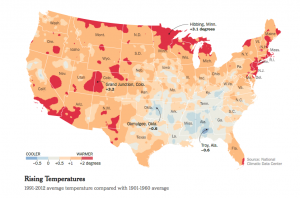There are hundreds of documents reviewing climate change. How can you be sure of which ones are accurate? In order to ensure you are receiving solely factual information, it is important to evaluate the credibility of sources while reviewing them. There are several factors to assess when ensuring a source is factual and relevant.
- Is it peer reviewed?
- Is it supported with evidence?
- Do the authors/organizations have relevant expertise?
- Do credible organizations agree with this information?
One news article relating to the effects of climate change is “U.S. Climate Has Already Changed, Study Finds, Citing Heat and Floods” by Justin Gillis. This article was published by the New York Times in May of 2014.
The main strength of this article is its abundance of relevant evidence. The whole of the article is reporting on the findings of the National Climate Assessment, which was published earlier that year. The article is arguing that the climate has already changed, due to anthropogenic causes. One relevant piece of evidence it provides is a U.S. map showing temperature change, provided by the National Climate Data center.

The National Climate Assessment is an extremely credible source, summarizing current and future impacts of climate change on the United States. It was produced with the help of over “300 experts guided by a 60-member Federal Advisory Committee… which was extensively reviewed by the public and experts, including federal agencies and a panel of the National Academy of Sciences” (National Climate Assessment). While it is unclear whether the article itself was peer reviewed, nearly all of the information listed comes directly from the National Climate Assessment, which was thoroughly researched and reviewed.
It also cites other credible sources, such as direct statements from former President Barak Obama, and several climate scientists. One climate scientist, Richard B. Alley, was not involved in writing the report, but is quoted in the article. According NASA, Dr. Alley has “authored many publications, chaired the National Academy of Sciences’ and National Council’s panel on abrupt climate change, has been involved with advisory groups to improve national and international research, and has been active with media outreach translate research findings to a broad audience with appearances on television, radio and print outlets”. This makes him a credible source.
The author of the article, Justin Gillis, is a frequent New York Times journalist and has been nominated for a Pulitzer Prize for Breaking News Reporting. He has also been reviewed by Climate Feedback, a site where climate scientists review the validity of articles. The majority of his articles listed were cited as having “very high” scientific credibility. While fairly left leaning, The New York Times itself is a well known, reputable newspaper. It was founded in 1851 and has won 122 Pulitzer Prizes- more than any other newspaper.
I have come to the conclusion that this is a reliable, factual article, which provides brief, yet thorough account of the most pressing pieces of information from the National Climate Assessment.
Sources:
Gillis, Justin. “U.S. Climate Has Already Changed, Study Finds, Citing Heat and Floods.” The New York Times, The New York Times, 6 May 2014, www.nytimes.com/2014/05/07/science/earth/climate-change-report.html. Accessed September 24th, 2017.
Dunbar, Brian. “Meet Dr. Richard Alley: Evan Pugh Professor in the Department of Geosciences and the EMS Environment Institute at the Pennsylvania State University.”NASA, NASA, www.nasa.gov/vision/earth/environment/sealevel_alley_bio.html. Accessed September 24th, 2017.
“Analysis of ‘Seas Are Rising at Fastest Rate in Last 28 Centuries.’” Climate Feedback, 21 Feb. 2017, climatefeedback.org/evaluation/sea-level-rise-global-warming-climate-change. Accessed September 24th, 2017.
“Overview.” National Climate Assessment, nca2014.globalchange.gov/highlights/overview/overview. Accessed September 24th, 2017.
